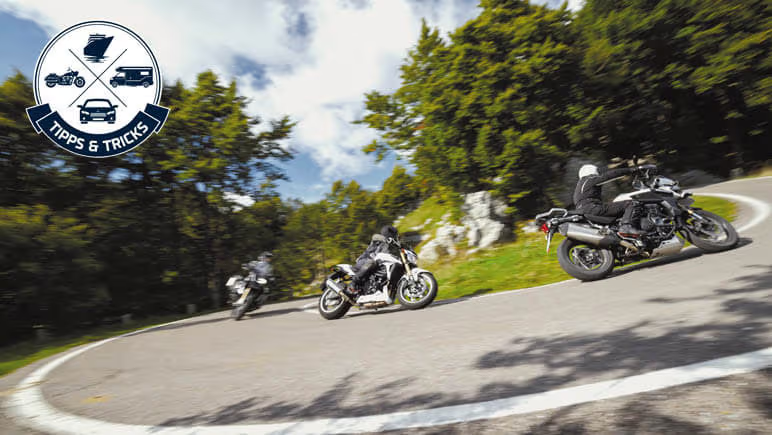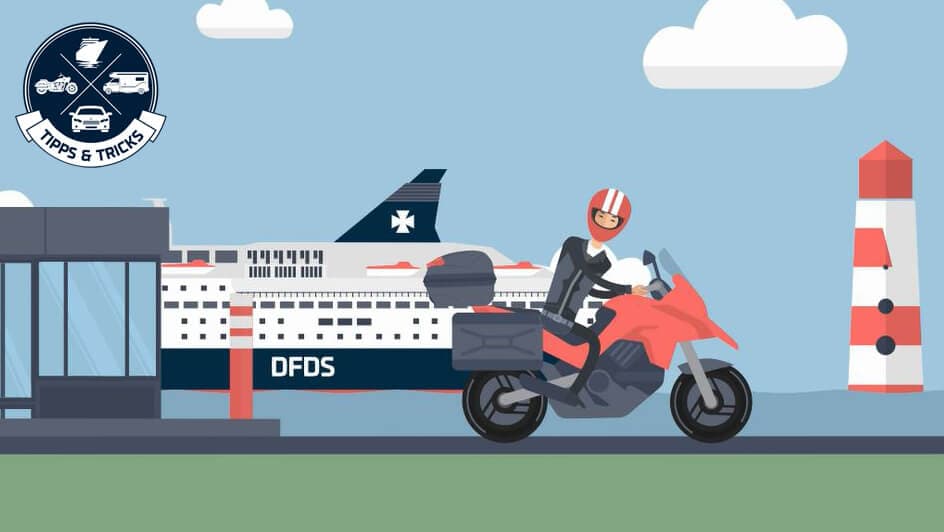Just pack your bags, put them in the trunk and off you go to the ferry? Unfortunately, if you start a holiday with your own motorcycle, it is not quite so easy. Especially before longer motorcycle trips, there are a few things to consider and prepare. After all, the machine should work safely and reliably over several hundred kilometers and the fun of the journey should not be neglected. We'll show you how it's done!
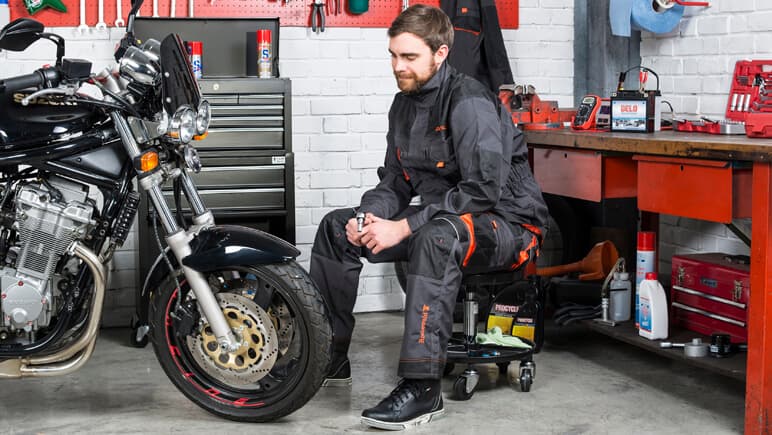
Hardware testing before the motorcycle trip
Before checking your machine, think about how far you want to ride, what is the profile of the roads, what is your riding style and what load does the motorcycle have to carry. Then go through the following checklist:
Tire: Are there sufficient tread reserves that will last until the end of the tour? Some road surfaces can be a real tread eater and personal driving style also influences the range of tyres. If in doubt, it's better to put on new tires before the trip!
Engine/Transmission: Are inspections and oil changes due soon? If so, it is advisable to prefer them to a trip by motorcycle. This is good for the machine and gives you a feeling of security.
Chain: Take the chain cleaner in your hand and clean the chain properly. This reduces consumption and increases performance. But beware! If the chain can be pulled back from the sprocket by more than 2-3 mm, the wear limit is not far away and the chain should be replaced before the holiday.
Brake: The weight of luggage puts a strain on the brakes. So be sure to check the pad thickness before the start of your holiday and replace the brakes in good time instead of risking losing the brakes.
Electrics: A spritz of the WD40 all-purpose spray on all contacts helps against moisture and dust on the journey - this protects against moisture and corrosion and makes operation smooth.
This should be on board if the worst comes to the worst: On-board tools/multitool, chain spray/oil, engine oil/canister, adhesive tape/cable ties, breakdown kit/repair kit, air pressure gauge, spare bulbs, fuses and flashlight
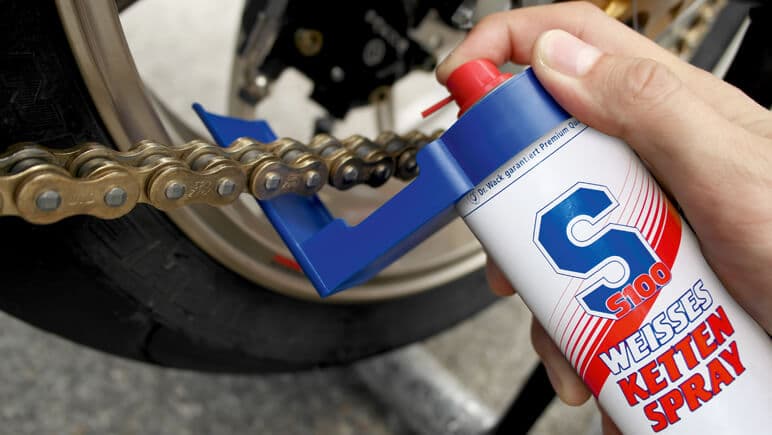
Tips for repairs on the road
Most motorcycles today are so reliable that you can easily go on a holiday trip with them. Nevertheless, it makes sense to be prepared for unpleasant surprises. And of course, the normal maintenance work has to be done on the way. The Louis mechanic tips as an aid can also be accessed on the go.
Chain care: If your own machine does not have a cardan or timing belt drive, the drive chain must be lubricated and tensioned on longer tours – preferably with the white chain spray from S100 in a 75 ml can. This is enough for a trip of several weeks. In most cases, the standard on-board tool tool is sufficient for readjusting the chain tension.
Engine oil: On long journeys, engine oil should be on board - in the practical and compact 0.5 litre canister FuelFriend.
Electrics: Light bulbs are quickly replaced, provided you have the right assortment of main headlight, rear light and turn signals with you. Self-welding insulating and sealing tape helps against chafed cables.
Tire: I've already experienced everything: In the evening I parked the motorcycle in the hotel garage and in the morning I realized that you had caught a nail somewhere. Usually it's Sunday and the nearest tire dealer is 50 km away. Then the Procycle puncture kit proves to be a saviour in an emergency. But beware: With a tire repaired in this way, please only drive to the nearest workshop! A precise air pressure gauge from Flaig is also recommended so that cornering pleasure does not suffer from incorrect tire pressure. Another tip for machines with rare tire dimensions: When touring long distances, check beforehand whether these tires are available in the destination area and, if necessary, order them in good time.
And if things go wrong... you hit roll grit with your foot when stopping and simply slip away: Some injuries can also be treated with good adhesive tape or cable ties. If the standard on-board tools are overwhelmed, the Rothewald Mini Ratchet and Bit Set is recommended.
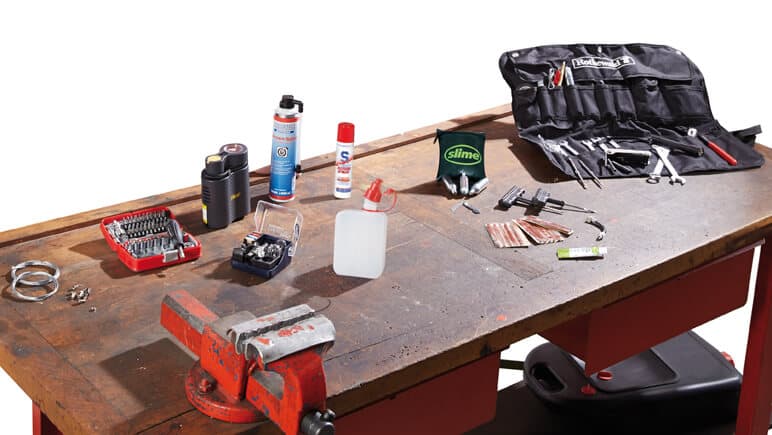
How do I store my luggage correctly and safely?
With luggage – especially with a pillion passenger – the usual riding behaviour changes because the overall centre of gravity shifts backwards and upwards. The motorcycle becomes more unwieldy, reacts more sluggishly to steering impulses and has an increased tendency to flutter the handlebars. If you follow the following rules when loading, you will minimize such problems:
Heavy items and everything that is needed on the way in the tank bag.
Pack heavy things in the suitcases to the front and bottom.
Load side cases as much as possible.
Only pack light luggage on the rear.
No heavy or hard things in the backpack – risk of injury!
Lash everything tightly and flutter-free and tighten it if necessary during breaks.
No luggage on handlebars and forks!
Do not exceed the permissible total mass – see vehicle registration document!
Observe the manufacturer's loading and speed recommendations.
Make sure you have enough freedom of movement!
Do not cover the turn signal and rear light!
Check the steering angle and view of instruments.
Adjust the suspension: Adjust the spring preload and possibly damping.

Luggage systems for holidays with motorcycles
How do you store your belongings on the motorcycle in such a way that they arrive safely and dry and interfere as little as possible while riding? Not every luggage system fits every type of motorcycle. Here is an overview of the most common systems and what they are particularly suitable for:
Tank bag: Suitable for almost all types of motorcycles. Problematic for sports enduros due to lack of space and for motorcycles whose instruments are mounted on the tank (e.g. Harley-Davidson). Pros: Has the least impact on the balance of the bike – ideal for heavy luggage such as tools and anything you want to have quickly at hand on the road. Depending on the size, a tank bag offers clearly noticeable wind protection on unfaired machines.
Side cases: Suitable for tourers, sports tourers, naked bikes and travel enduros. Advantages: The waterproof boxes made of plastic or aluminum are lockable and therefore quite theft-proof. In addition, they sit firmly on the motorcycle and can withstand relatively heavy loads.
Saddlebags: Suitable for pretty much all motorcycles with pillion seats, including super sports bikes. Advantages: For occasional tours and especially for choppers and sports motorcycles, saddlebags made of textile material or (artificial) leather are a cost-effective and lightweight alternative to side cases. Important: The saddlebags absolutely need a sufficient safety distance from hot exhaust mufflers!
Top case: Suitable for all machines on which a corresponding carrier can be mounted. Advantages: Many top cases are so large that 2 helmets fit inside. Like side cases, they are waterproof and lockable. Important: Follow the manufacturer's recommendations regarding loading and maximum speed.
Tail bag: Suitable for all machines with a pillion seat or luggage rack or a sufficiently sized seat hump. Advantages: Textile tail bags are ideal for motorcycles that cannot be fitted with suitcases or large tank bags. Moisture protection is provided either by rain hoods or a waterproof interior. The division into individual compartments creates order.
Luggage roll: Suitable for all machines with pillion seat or luggage rack. Luggage rolls must be fixed to the motorcycle with lashing straps. Tip: Luggage rolls are waterproof, but air still escapes through the closure. Therefore, the lashing straps should be retightened at the first break. Advantages: Luggage rolls are the lightest, cheapest and most universal transport containers. Depending on the size, entire camping equipment can be accommodated in it.
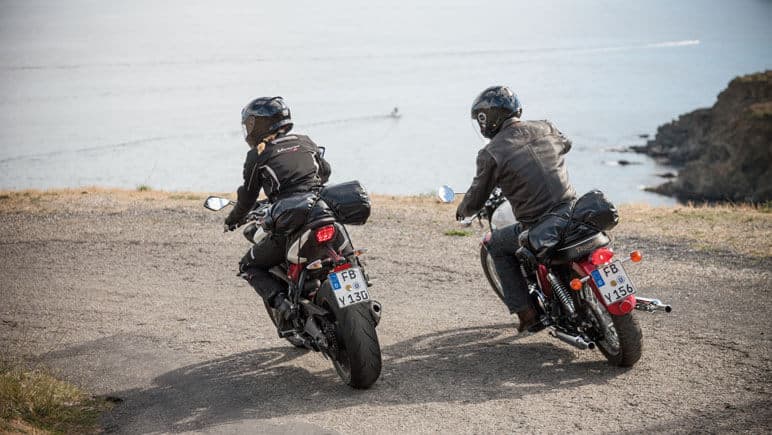
What should you pack for longer motorcycle trips?
Especially when travelling by motorcycle to the northern destinations of the DFDS ferries, the good old onion principle proves its worth: several thin layers on top of each other keep you warm better than one thick one. It also allows you to react flexibly to changing conditions on the go.
Functional underwear: It serves active safety by protecting the rider's condition and preventing overheating and cooling. In order not to interrupt the moisture transport between the underwear and the climate membrane, the warming second layer should also be made of functional fibres (e.g. fleece). Ideal for traveling: Functional underwear dries extremely quickly. You can wash them out in the evening and put them on again the next morning. It is also light - and who wants to carry more luggage than necessary?
Rainwear: If you prefer to ride in leather, you definitely need a rain suit, possibly also gaiters for the boots and overgloves. By the way, such a waterproof overcoat also insulates remarkably well against the cold.
Protectors: A complete equipment with protectors should be a matter of course for jackets, trousers and boots. Tip: Back protectors that are worn separately under the jacket are usually longer than integrated ones and protect the lumbar region better.
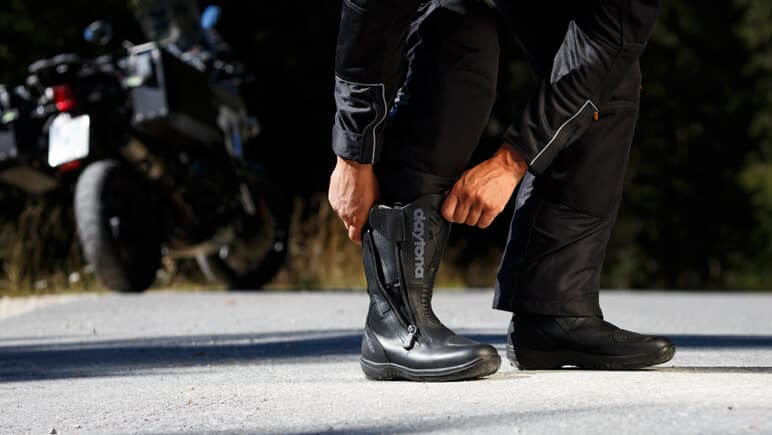
A few things (apart from the practical breakdown helpers above) should not be missing on any motorcycle trip and should be packed in such a way that they are quickly at hand:
Water bottle, preferably with water or fruit juice spritzer
Snacks: chocolate or muesli bars for a quick energy boost
Visor cleaning cloths for a clear view
Spare or undergloves for changing weather conditions
Map – not only for navigation grouches
Flashlight when it's getting late again
Mobile phone, in case you need help
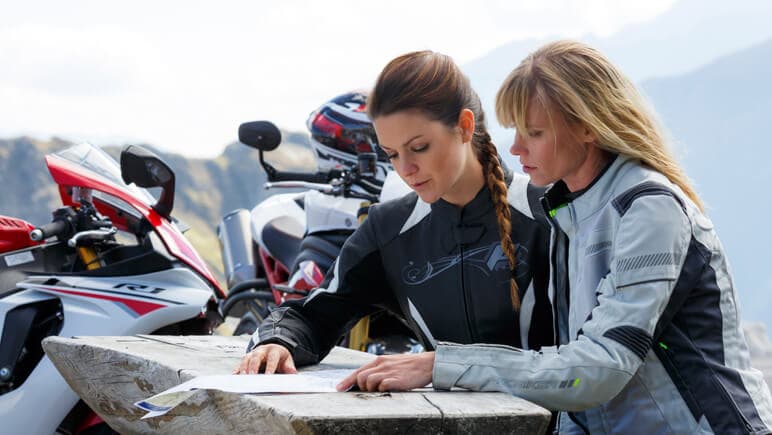
Now you can start your journey with your own motorcycle! P.S.: When the first stage leads to the DFDS ferry, we will show you in a video how you should lash your motorcycle safely on the ferry.
Have you already gained experience with motorcycle tours and do you have practical tips for touring novices? Then write it to us in the comment field below!
Would you like to have a professional help you prepare for your tour with your own bike? In every Louis store you will find everything you need for a holiday with your own machine – including expert advice and equipment. The sales staff knows exactly what is important for which destination and what is not. In the service area of the Louis online shop, there is plenty of information and inspiration for travelling by motorcycle: from mechanic tips, tour suggestions and tips on camping equipment, to information on traffic rules in the most important European travel destinations. As far as the equipment with travel accessories is concerned, the bike specials are a great source of inspiration. Here, Louis presents a wide variety of motorcycle models with the matching accessories.
Photos © Detlev Louis Motorrad-Vertriebsgesellschaft mbH

